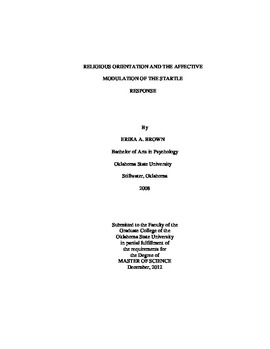| dc.description.abstract | The current study integrated research on one's religious orientation (Allport, 1966; Allport & Ross, 1967) and the affective modulation of the startle response, specifically motivational priming theory (Lang, Bradley, & Cuthbert, 1990). The primary goal was to differentiate between individuals in four religious orientation groups using their autonomic responses to religious images. A secondary aim was to improve upon current protocol for classifying individuals into religious orientations. Autonomic data were collected first using the Affective Modulation of the Startle Response task, followed by participants' conscious ratings of the images using the Self-Assessment Manikin (Bradley & Lang, 1994). Finally, in counterbalanced order, participants completed a standard measure of religious orientation: the Intrinsic/Extrinsic-Revised Scale (Gorsuch & McPherson, 1989), the Religious Orientation Vignettes (designed to improve upon the current methodology), and a Religious Affiliation and Behaviors questionnaire. Data were analyzed using Observation Oriented Modeling (Grice, 2011). The pattern predicted under motivational priming theory (Lang, Bradley, & Cuthbert, 1990) was not found in the autonomic data. As a result, the four religious orientation groups could only be differentiated using the conscious ratings. The intrinsic group responded most favorably to the religious images, followed closely by the extrinsic and indiscriminate groups. The nonreligious group responded least favorably. A pattern analysis revealed a 71% overlap between the standard method of using median splits (Hood, 1970) on the Intinsic/Extrinsic-Revised Scale (Gorsuch & McPherson, 1989) and the Religious Orientation Vignettes in the classification of individuals into religious orientation groups. It is suggested that the Religious Orientation Vignettes provide a more straightforward, theoretically sound method of classification than the Intrinsic/Extrinsic-Revised Scale for all four religious orientations, especially the nonreligious group. | |
